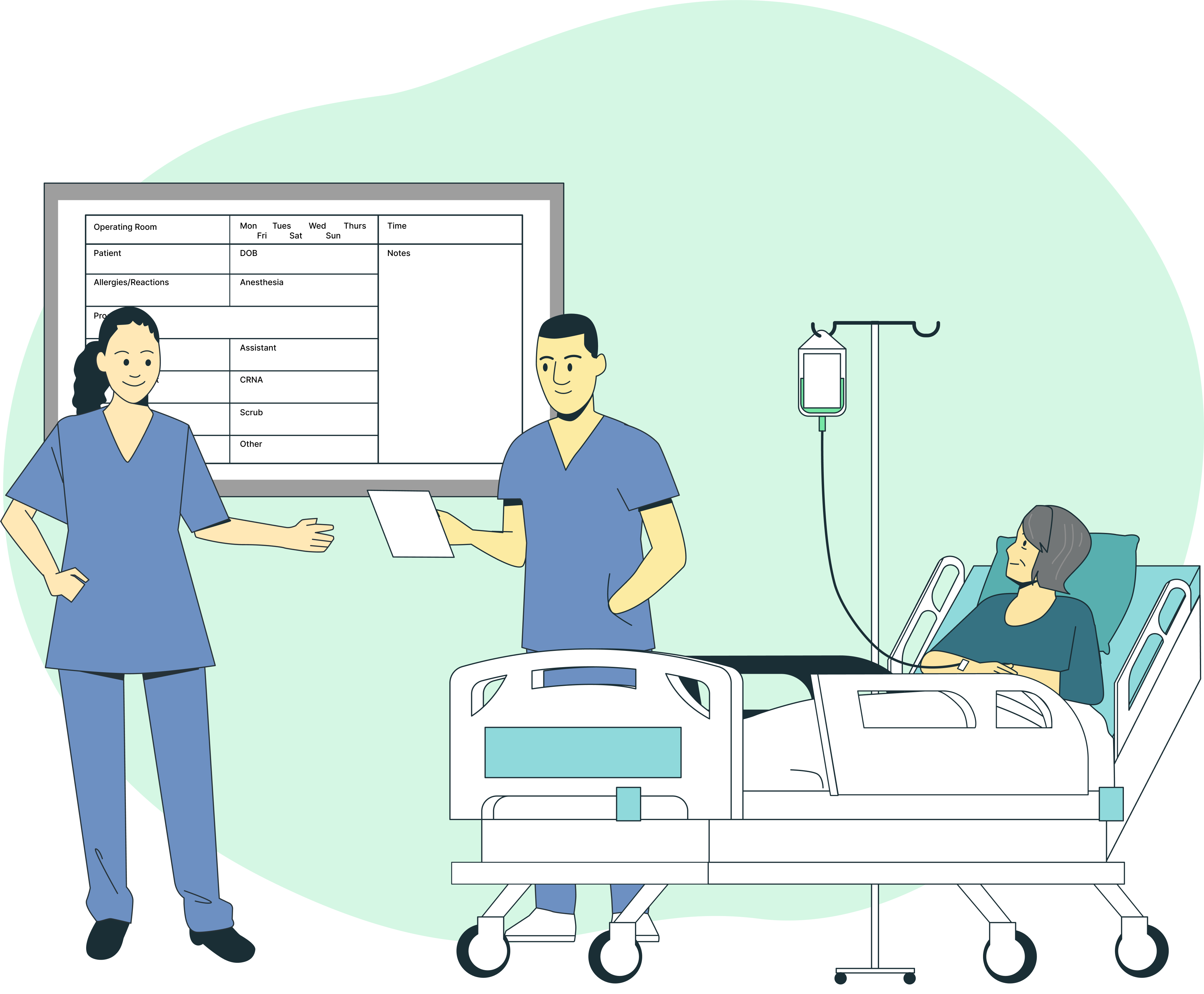Hardwire Bedside Shift Report
How We Hardwire Standard Communication
- Tools and training to hardwire standardized communication at the change of shift.
- Optimize patient safety by ensuring that critical information is consistently and accurately shared among the care team and with patients.
- Enhance effective collaboration between off-going and oncoming staff.
- Streamline the start of shift for nurses and ensure that they start on the front foot.
A 300-bed hospital with 2 shifts a day will complete:
Do It Right & Make It Stick
Nurses First elevates Bedside Handover into an elite competency.
Using a standard bedside handover form offers consistency in the data but not necessarily the handover. Having a policy and having it performed with excellence on the front lines can be two different realities.
Elevating Bedside Handover from a task to a skill that is practiced every shift enables nurses to become experts through mastering these new skills. The winning recipe is the same: Learning, Practice, and Feedback.
- Follow the list of high-performance behaviors that make Bedside Handover go really well for everyone.
- Set a goal for units to achieve Bedside Handover Excellence, which means all nurses are verified as experts in Bedside Handover.
That’s what makes it stick.
Notice a better start and end to shifts, better use of everyone’s time, and better care, both for patients and each other.
Milestones to Implement & Hardwire N1
Week 1
Stakeholder engagement with nursing leaders
Webinars, information packs, readiness reviews
Week 4
Sign contracts
Confirm the size of implementation and a preferred timelineWeek 6
Onsite #1
- Meet with unit nurse managers & charge nurses
- Customize tools for each unit
Week 8
Onsite #2
- Skills training
- Train skills assessors
- Launch up to 11 units in 1 week
Week 12
Onsite #3
Launch skills verifications
Week 16
Achieve Nurses First Excellence
Nurses are trained, verified and confident in the new bedside handover process. Handover is more effective, efficient and patients are engaged.
Nurses first
Hardwire patient-centered communication at each shift
Frequently Asked Questions
Share your vision with your staff. You can use our videos.
Many Nurse Managers like to get staff buy-in through 1-on-1 conversations. Some will also send around a video of a gold standard Bedside Handover, to show what’s possible.
Points to emphasize with your staff:
- This is an easy way we can care for one another each shift
- It’ll save us time and be safer for patients
- It’ll elevate how patients see us and feel cared for
Even veteran nurses who feel confident in their handoffs agree that when they hear information in the same predictable order every time, their brains can start making sense of the information right away.
Make learning short and sweet.
Nurses are busy – we like to learn in quick little bites and then get back to work.
So, on our units, we teach the basics with (1) a few short “how and why” videos and (2) a quick in-service training.
And make feedback objective, specific, and real-time.
Skills assessments help deepen the learning and reveal individual blind spots.
This trio of learning modalities — online training, in-service training, plus assessment and feedback — is what works best on our units.
Skills assessments work best with objective criteria.
On our units, we call these “high-performance behaviors.”
First, we start with the simple recognition that doing a Bedside Handover is more than a task. It’s a core nursing competency. Plus, it’s the rare nursing skill that integrates a patient, a colleague, and a tool at the same time.
To make it easier, friendlier, and more useful, we developed 9 High-performance Behaviors that make Bedside Handover go really well for everyone. These behaviors boost collaboration, patient participation, and professional courtesy.
Here are a few of ours, refined from observing thousands of handoffs:
#3: Read through the Bedside Handover Report from start to finish without jumping around
#4: Speak directly to the patient and address them directly as “you”
#5: Use words patients understand, for example, “to prevent blood clots” instead of “VTE prophylaxis”
#7: Inform the oncoming nurse of pending tasks, orders, medications, and labs
Empower charge nurses as assessors, and let them loose.
We all have blind spots. And we usually prefer to learn about those blind spots in a way that is private and constructive.
So, on our units, we empower a pool of unit assessors — such as charge nurses — to conduct real-time skills assessments at the bedside. Each assessment is an objective evaluation of the 9 High-performance Behaviors. During a Bedside Handover, was each behavior demonstrated?
The assessor watches a handover, checks the boxes next to each successful behavior, and privately shares the results back in the hallway.
This simple process delivers feedback that is real-time, objective, and specific to show what needs work. Now the outgoing nurse who delivered the handover knows exactly how to improve for the next patient. That’s empowering.
A nurse who earns an 8-out-of-9 for three different Bedside Handovers is considered to be verified as competent.
It takes around 5 weeks for a 25-nurse unit doing 4 assessments per weekday. Not a small effort, but also not particularly cumbersome — especially given the tremendous value of standardizing these important skills.

